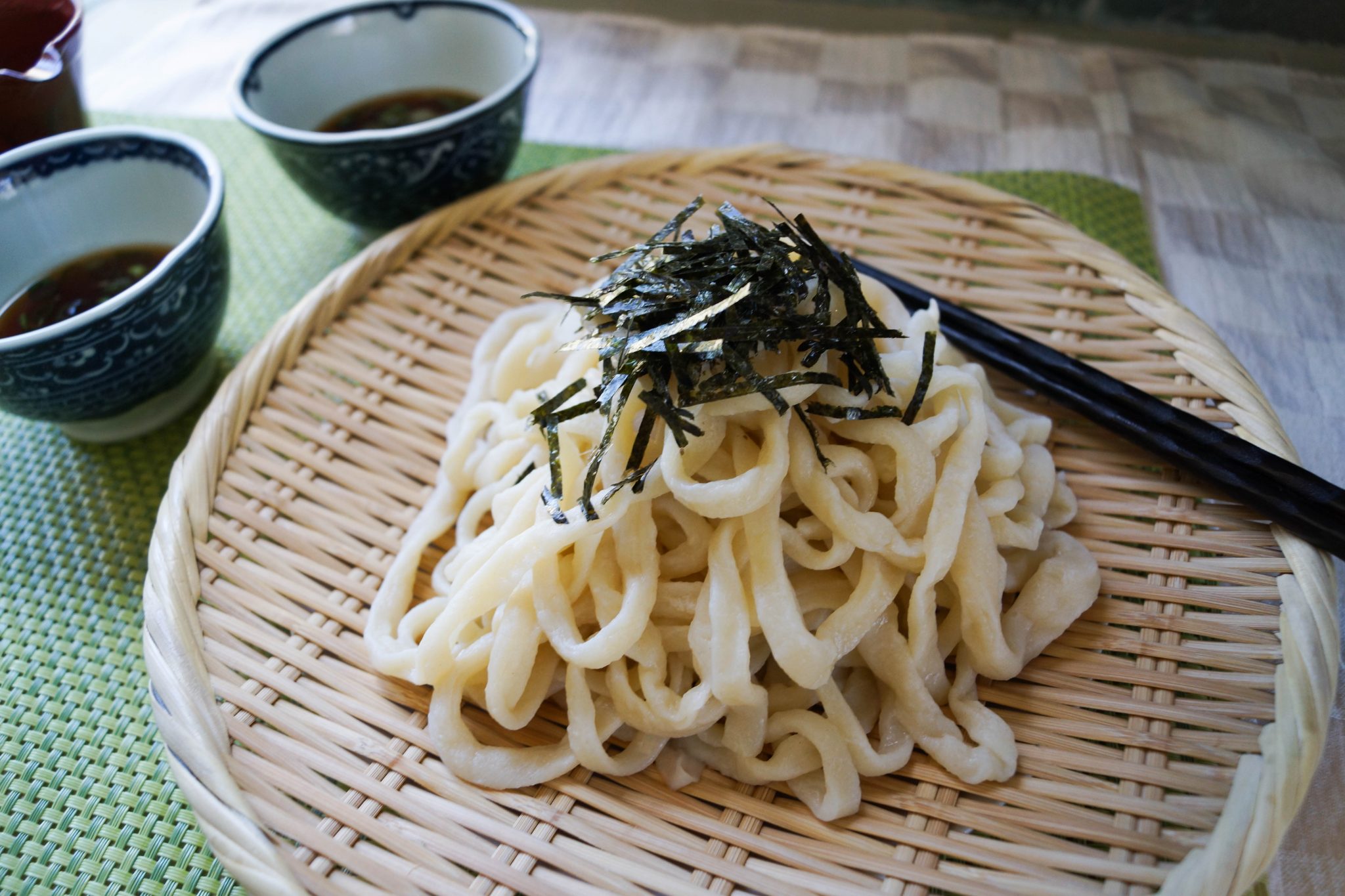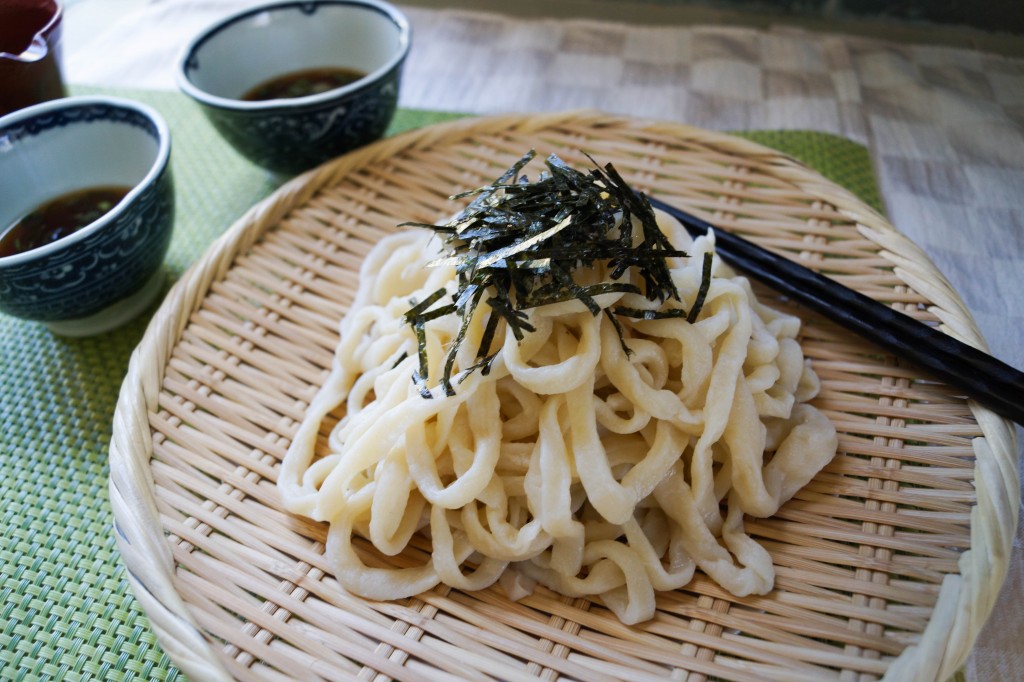Udon are Japanese wheat noodles. They are made from all purpose flour, water and salt. Very simple affair, so it seems. Japanese Udon artisans make Udon that look like the ones made by machines. You can see those artisans making Udon noodles through the window at the front of good Udon restaurants. It is actually pretty amazing to watch. Udon is sometimes eaten hot in seasoned broth, but other times, it is eaten cold and dipped in sauce. It is an extremely popular lunch food in Japan and also in the US. A lot of Japanese restaurants in the US serve Udon and stores sell the noodles for home cooking, but you can make it at home. And not just the dish, I mean you can really make the Udon noodles themselves.
Because you can buy Udon noodles in many forms such as frozen or dried at many supermarkets, you might think it’s not necessary to make home-made Udon noodles. However, there are 3 reasons to make Udon at home:
1. You may like making fresh noodles at home. That’s me. I like making things from scratch. It is safe, preservative and other unwanted chemicals free. That’s can be a big deal for some people with a health conscious mind.
2. It tastes better made at home. This is just so true for any food. Home-made Udon has a different texture from store-bought, especially the dried kind. It is thicker, firmer, and heartier. Home-made Udon doesn’t get soft and soggy while you are eating it.
3. It is fun to make Udon. You knead the dough with your feet! Stepping on the dough may sound strange, but that’s the traditional way of making Udon in Japan. Get your family and friends involved in this process, and they’ll like doing it.
It’s not hard to make, but it will take some time letting the dough rest, and to roll it out, etc. The cost of ingredients is close to nothing, but you can put some labor in it. No one is an Udon artisan here, so it may not look perfect. Some noodles might be thicker than the others … but that’s OK. They still taste great. Hope you enjoy both making and eating home-made Udon!

Homemade Udon Noodle Recipe
Instructions
- Mix warm water and salt well until the salt is dissolved.
- In the bowl of a stand mixer, add salt water and flour. Mix with a dough hook at medium speed about 5 minutes. Wrap the dough in plastic and let it rest at least 3 hours in the refrigerator (preferably overnight).
- Take the cold dough from the refrigerator and let it return to room temperature. ((Remove from plastic and knead by hand for a couple of minutes until the dough becomes smooth and elastic. Cover and let it rest for 20 minutes.)) Put the dough in a strong 1 gallon plastic bag (such as a zip freezer bag), leaving it at least partly open to allow air to escape. Then put the bag of dough on the floor. Step on the bag of dough and knead with your feet until the dough spreads out, taking up the whole bag. Take the dough out and fold in half twice, into a smaller square. Repeat this kneading and folding 2 more times. Shape the dough into a ball and let it rest 20 minutes.
- Roll out the dough to 3 mm (1/8″) thick about the size of 50cm x 35cm (20″ x14″) sheet, dusting well with a lot of flour so that it doesn’t stick, and fold the dough into 3 layers. Cut the dough to 3 mm width noodles.
- Boil water in a big pot, and boil the noodles for 10-15 minutes. Strain and wash. Use as directed in recipes.
Video


25 Comments
I love this recipe! As you say, it’s really fun to make the udon at home and gives a special touch to the dish ^^
However I would like to ask you a question: is it a good idea to freeze the noodles in order to cook them another day? Or maybe is it better to keep them in the fridge?
Thank you!
Ada,
you can cook the noodles first, then freeze by indivisual servings. You don’t need to defrost if you are using in hot soup.
Hi There!
Lovely guide on how to make Tuechi Noodles. Just one thing; is it possible to make these by hand during the mixing process? I don’t have a electronic mixer, just a bowl and my hands :), Also, is the fridge step necessary? I don’t have that either, ore wa bimbo
Thanks.
Mohseen,
you could kneed by hands, but it’ll take for a long time, probably 15 minutes? You have to let the dough rest. I guess you could do it at room temperature in winter. Good luck!
I was wondering how long I should wait for the dough to come to room temperature
Tiffennie,
30 minutes at least.
Thanks for this recipe, my husnand and I are excited to try this!
Aimee,
you’ll have fun making it with your husband!
I made these mostly following the instructions, kneaded by hand 10 minutes, overnight rest in the fridge, brought to room temperature, once stepping in the bag (too difficult to remove, stuck to the walls), some hand kneading to compensate, and then rolled out and cut, cooked them 9 minutes and they all fell apart into little 1 1/2″ pieces. Not at all like the teuchi udon I’ve had in Nagoya. I halved the recipe but forgot to halve the salt.
How do you get nice long chewy noodles that hold together?
Ayumi,
wow 1 1/2″ pieces…that’s too bad the recipe didn’t work well with you. Did you measure ingredients exactly? No substitution on ingredients? Followed instructions exactly?
Do you really need to cook for that long? most homemade noodles and pastas only cook for a minute or two or they turn to mush. I cannot afford to waste ingredients..
Blue,
we believe so:) If you don’t want to experiment, there is always frozen or dried Udon that is perfectly good!
20g of salt is way too much… I just dumped my whole batch of noodles!
And don’t cook it for 10-15 minutes either! 5 tops!
CK,
it may take shorter depending on how thin you cut the Udon dough. It took us that much when we’re cooking.
CK,
it sounds like a lot of salt, but a lot of it will reach out when boiling.
I can hardly wait to make these, I have seen a recipe that recommends wrappibg the noodles in oilcloth to knead them on the floor. I think your plastic bag will woork better. I really enjoy Japanese foods.
MARTHA,
thanks! I hope you like our Teuchi Udon. You can also try our chicken udon using your homemade noodles.
Hello there! I just tried making the udon noodles and I think they turned out fantastic! However, it was very hard to roll it out (I had to have my husband help lol). Is it supposed to be hard to roll out or should I add more water?
Erica,
It is hard to roll! Let the dough rest enough and that will help too.
Hi there! I don’t have a stand mixer, I only have a hand mixer. Since it doesn’t have the dough hook, could i supplement the kneading with my hands? how long would that take?
thank you
Melissa,
you can knead by hands until smooth. Good luck.
Can I use these noodles in a stir fry?
Teresa,
yes you can! We have Yakiudon recipe for that!
I made this today and it was wonderful! Very chewy yet also soft.
I didn’t think this would work because other recipes use strong/bread flour, and much less water. Yet this worked great. It was tricky getting it dough out of the plastic bag because it likes to stick to it, and my noodles stuck together int he pot because I didn’t use flour when slicing them because I ddin’t want too much starch in the water. But even when they stuck they still tasted great.